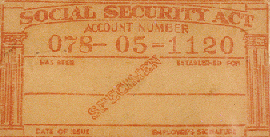It’s a bad idea to keep your Social Security card in your wallet (despite the fact that the card says you should), but it used to be common practice. In 1938, before identity theft was the problem it is today, a wallet manufacturer wanted to show potential buyers how well their Social Security cards would fit in their wallets, so they put fake ones in the ones they sold (similar to cardboard “credit cards” you may see in wallets today).
The cards in the wallets were fake, but the number on them wasn’t. Douglas Patterson, vice president and treasurer of the E.H. Ferree Co., thought it would be “clever” to use his secretary’s Social Security number on the cards, according to a post on the Social Security Administration’s history page. The secretary, Hilda Schrader Whitcher, eventually had to be issued a new number, because so many people thought the number in their wallets belonged to them.
Thousands of people used Whitcher’s number (078-05-1120), despite the fact the display cards were half the size of actual cards, printed in all red and said “specimen” on them. Use of Whitcher’s number peaked in 1943 when 5,755 used it as their own, and it was used as late as 1977, the Social Security Administration notes. Overall, more than 40,000 used the number, as the wallets were mass-produced and sold in department stores across the country.
 Based on the SSA’s post about this number, it doesn’t seem Whitcher ran into too much trouble because people used her number, though the FBI apparently showed up at her house once to ask about the situation. She was amazed people took the number in the first place, according to a quote posted to the SSA website:
Based on the SSA’s post about this number, it doesn’t seem Whitcher ran into too much trouble because people used her number, though the FBI apparently showed up at her house once to ask about the situation. She was amazed people took the number in the first place, according to a quote posted to the SSA website:
“They started using the number. They thought it was their own. I can’t understand how people can be so stupid. I can’t understand that.”
As entertaining as this story is, someone stealing your Social Security number is something you never want to experience. An identity thief can file for a fraudulent tax return, commit crimes or open a variety of financial accounts in your name, all of which could negatively affect you. It’s not just finances, either — you may have to clean up your criminal or health records after becoming an identity theft victim.
It can sometimes be tough to detect identity theft, but one of the easiest ways to spot new-account fraud is to check your credit reports and credit scores. You can get your free annual credit reports from the three major credit reporting agencies, and you can see two of your credit scores for free, with updates every 14 days, on Credit.com.
Identity theft can cost you a lot of time and money, which is why you want to find and stop it as quickly as possible.
More Money-Saving Reads:
Main image: iStock; Inset image: Social Security Administration
You Might Also Like
September 13, 2021
Uncategorized
August 4, 2021
Uncategorized
January 28, 2021
Uncategorized






